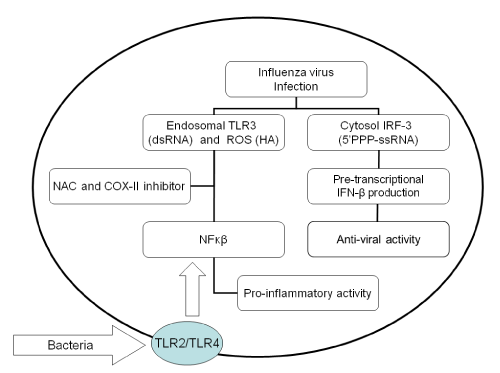
 |
| Figure 4: Schematic diagram showing the different activation pathway of pro-inflammatory and anti-viral activity in influenza infection: During the early phase of influenza infection, the induction of pro-inflammatory activity is through NFκB activation by toll-like receptor 3 (TLR3) stimulation via endosomal dsRNA and reactive oxygen species (ROS) production via haemagglutinin (HA)-induced endoplasmic reticulum overload (ER-overload) whereas the induction of early anti-viral activity is through the induction of pre-transcriptional interferon-β (IFN-β) production via activation of cytosol interferon regulatory factor 3 (IRF3) by binding of retinoid-inducible gene I (RIG-I) by 5’PPP-containing single stranded RNA (5’PPP-ssRNA). Therefore, anti-oxidants COX-2 inhibitor and paracetamol by targeting the NFκB pathway can block the human pro-inflammatory activity without compromising the human antiviral response. Since gram positive and gram negative bacteria can activate NFκB through surface membrane toll like receptor 2 and 4 (TLR2/ TLR4) respectively [325-333], NAC is unable to block bacteria-induced NFκB activation. |